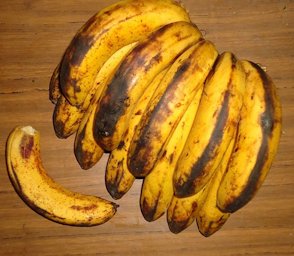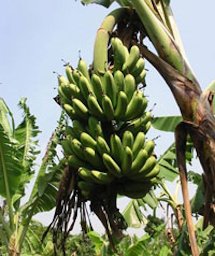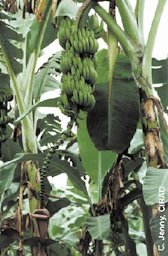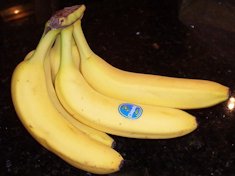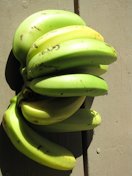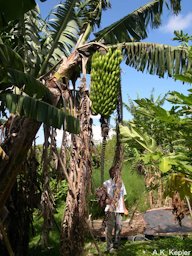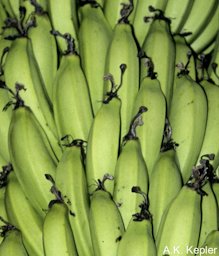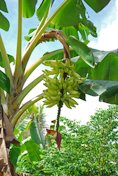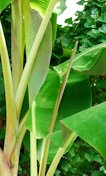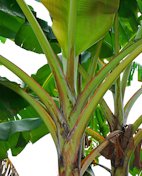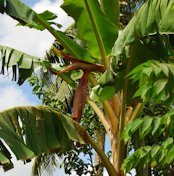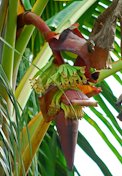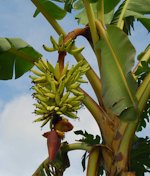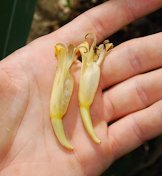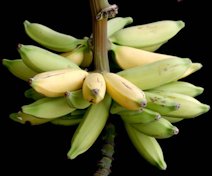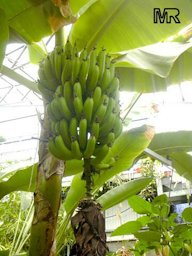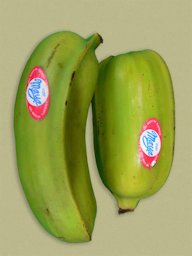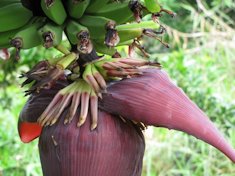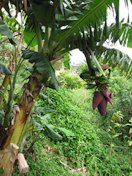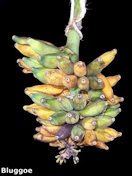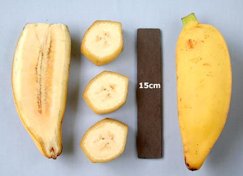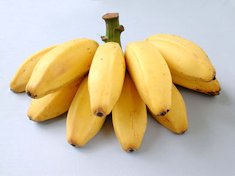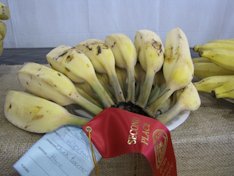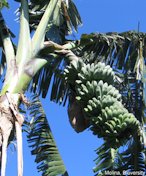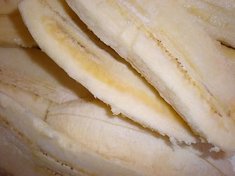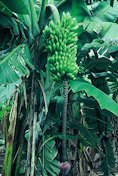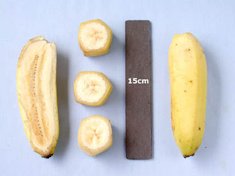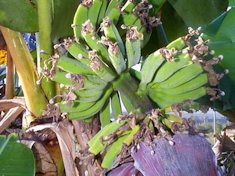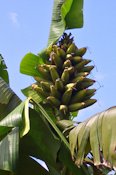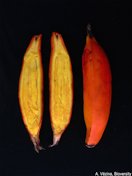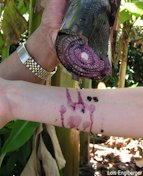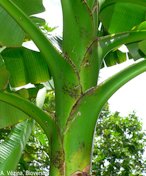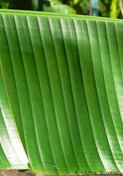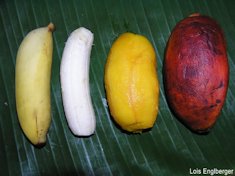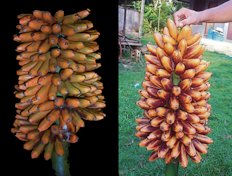Banana Varieties There are many banana cultivars. Parents of the cultivated types are Musa acuminata and Musa balbisiana, two wild species which are usually seedy. M. acuminata evolved primarily in tropical rainforests in Southeast Asia, whereas M. balbisiana originated in monsoon areas in northern Southeast Asia, and southern Asia. Thus, pure M. acuminata cultivars developed first in Southeast Asia and its hybrids with M. balbisiana arose where distributions of the two species overlapped. 1 Because the binomial Latin nomenclature for edible varieties, e.g. Musa cavendishii cultivar (cv.) Williams, proved unsatisfactory, they are referred to as, for example, Musa spp. (AAA Group, Cavendish Subgroup) cv. Williams. There are approximately 500 varieties of bananas and plantains. About 150 of these are primary clones, the rest are somatic mutants. 17 Banana cultivars are complex diploid, triploid, and tetraploid hybrids among M. acuminata and M. balbisiana. In general, those with a high proportion of M. acuminata produce sweet fruit, whereas those with a high proportion of M. balbisiana produce starchy fruit. 1 There are numerous banana and plantain cultivars listed in Table 1 and Table 2. However, many of them are not adapted to Florida's climate and are not readily available. Cultivars have many local names making identification of specific clones difficult by common name. To help avoid this, common names along with their A/B constitution and ploidy level are used. 1 Conventionally, the relative contribution of M. acuminata and M. balbisiana to the cultivar is indicated with A's and B's, respectively. They are further classified as to the presence of one or more sets of chromosomes (called ploidy level). For example, an AB is diploid, an AAB, triploid, and ABBB, tetraploid. Most familiar, seedless, cultivated varieties (cultivars) of banana are triploid hybrids (AAA, AAB, ABB). Diploids (AA, AB, BB) and tetraploids (AAAA, AAAB, AABB, ABBB) are much rarer; the latter essentially being experimental hybrids. 1 Genome Groups AA. AAA. AAB. AB. ABB. BB. BBB. AAAA. AABB. AAAB. ABBB There are several relatively new banana cultivars that produce excellent quality fruit and have resistance to one or more major banana diseases (i.e., Panama and Sigatoka diseases). 'FHIA-01' (also called 'Goldfinger') is an excellent dessert banana with resistance to Panama disease and Yellow and Black Sigatoka. 'FHIA-02' (also called 'Mona Lisa') is resistant to Sigatoka but susceptible to Panama disease. 'FHIA-03' is primarily a cooking banana but may be eaten fresh and is resistant to Panama, Moko, and Sigatoka diseases. 'FHIA-17' is a dessert banana with resistance to Panama disease and tolerance to Sigatoka. 'FHIA-21' is resistant to Back Sigotoka disease. These banana varieties are highly recommended for the home landscape. 1 Further Feading Sorting Musa Names ext. link Banana Cultivar Names and Synonyms in Hawai'i pdf Banana Growing in the Florida Landscape, University of Florida pdf Banana and Plantain an overview for Pacific Island Agroforestry, Agroforestry.net pdf Illustrated Guide for the Banana Varieties in the South Pacific, Australian Centre for International Agricultural Research pdf In the following list, cultivars and groups of cultivars with an acuminata/balbisiana heritage are listed within a given genome. Bananas that are hybrids between M. acuminata and M. textilis, and M. acuminata and M. schizocarpa are unimportant and not included below. The Australimusa section is also briefly covered. This work is based based on the nomenclature system introduced by Ernest Cheesman, Norman Simmonds and Kenneth Shepherd. They indicates the degree of genetic inheritance from the two wild parents and the number of (ploidy). Cultivars derived from Musa acuminata are more likely to be used as dessert bananas, while those derived from Musa balbisiana and hybrids of the two are usually plantains or cooking bananas. 1 AA. AAA. AAB. AB. ABB. BB. BBB. AAAA. AABB. AAAB. ABBB
The AA genome group comprises cultivars that have two sets of chromosomes inherited from Musa acuminata subspecies. They are often called edible diploids, in reference to their number of chromosome sets and to distinguish them from wild species, which are also diploid. AA cultivars have been largely displaced by the generally more productive triploid cultivars but are still cultivated in Malaysia, Indonesia, India, Papua New Guinea and the Solomon Islands. Their fruit are generally very sweet. Most of the cultivars in this group have not been classified into subgroups. 18 'Nino'/'Sucrier' (AA) 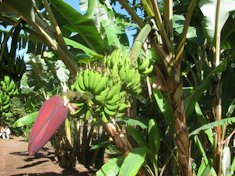 Fig. 1  More Images for 'Sucrier' The 'Nino", also known as the 'Lady Finger', 'Sugar' banana, 'Finger' banana, 'Fig' banana, 'Date' banana, or 'Sucrier'; in Spanish, as 'Dedo de Dama', 'Datil', 'Nino', 'Bocadillo', 'Manices', 'Guineo Blanco', 'Platano Roatan' or 'Cambur Titiaro'; in French, as 'Banane-figue', 'Banane mignonne', 'Figue sucrée' (West Indies), 'Banane figue sucrée', 'Banane doigt de dame', 'Banane naine', 'Banana ficaire', 'Banana "Sucrier'. Its official designation is Musa acuminata (AA Group) 'Lady Finger'. In Australia, the name 'Lady Finger banana' refers to another banana cultivar, the Pome banana ( Musa acuminata × balbisiana Colla (AAB Group) cv. 'Pome'). In Hawai'i and the West Indies, 'Lady Finger' is also used to describe the Ney Poovan banana cultivar (Musa acuminata × balbisiana Colla (AB Group) cv. 'Ney Poovan'). Following is a description from The Complete Book of Bananas: "The Nino is grown in all the tropics of the world. It is a seedless diploid that is rendered so by having sterile female flowers. (Simmonds 29.) The Nino is usually found in backyard plantings and I see no future for it as a commercial fruit despite its excellent taste. The racemes of fruit produced by the Nino are too small to justify putting out commercial-sized plantings. The fruit are tiny growing to no more than two to three inches in length. The largest racemes may weigh 20 to 25 pounds when grown under the best of conditions. They usually weigh about 10 to 15 pounds. The Nino is, however, an excellent fruit to produce for personal consumption. The plant grows to 18 feet when well grown. It prefers rich soils but can still produce small heads of fruit in poor soils. The Nino foliage is an unusual color of green with a slight tinge of yellow color in its leaves giving the plant a fluorescent green color. The pseudostem is light green with rich chocolate markings. The stem of the Nino is slender but it never is required to hold up a large head of fruit so wind is rarely a problem. The Nino is resistant to Panama Disease but it is attacked by nematodes and the corm borer." 2 'Sucrier' is considered to be resistant to Fusarium wilt. 34 'Inarnibal' (AA)  Fig. 2 It's accepted name is Musa acuminata (AA Group) 'Señorita'. 'Señorita' bananas also known as 'Monkoy', 'Sarot-sut', 'Cariños' or 'Cariñosa', 'Arnibal' or 'Inarnibal' in Negros Occidental (literally "syrup" in Hiligaynon), and 'Lunsuranon' in Surigao. It is also known as 'Pisang Lampung' in Indonesia. It is also commonly known as the 'Forty day banana' (Filipino/Spanish: 'Cuarenta Dias', Malaysian: 'Pisang Empat Puluh Hari'), a reference to the average amount of time between flowering and bearing fruits of this cultivar. 27 'Señorita' bananas are diploid cultivars of the banana Musa acuminata originating from the Philippines. They are very small stout bananas which, like all bananas belonging to the AA cultivar group, are known for being extraordinarily sweet. 5 Fruits of the 'Señorita' bananas are not as common as Lacatan and Latundan for dessert bananas in the Philippines, but they are still highly regarded for their exceptionally sweet taste and soft creamy flesh. They are seldom cultivated in large quantities due to their vulnerability to diseases and thus are more commonly found sold in small farmer stalls. They are popular treats for tourists visiting rural areas in the Philippines. 27 'Philippine Lakatan' (AA)
Its official designation is Musa acuminata (AA Group) 'Lakatan'. Other names: ‘Pisang Berangan Merah/Kuning’ (Malaysia), ‘Pisang Barangan Merah/Kuning’ (Indonesia), ‘Kluai Hom Maew’, ‘Kluai Ngang Phaya’ (Thailand); Mapang. A delicious, much-loved cultivar, commonly grown in the Philippines. Not to be confused with the tall Cavendish cultivar ‘Lacatan’ (AAA) also called Bungulan.The Cavendish cultivar 'Masak Hijau' (Musa acuminata Colla (AAA Group) cv. 'Masak Hijau') is also called 'Lacatan' in Latin America and the West Indies. The cultivar 'Lakatan' was originally described by Blanco as 'Lacatan', but the letter c was changed to the letter k to differentiate it from the American 'Lacatan' which is actually a Bungulan, and also called 'Jamaican Lacatan'. 4,5 Both the Jamaican and cousin Philippine 'Lakatan' produce a similar fruit in shape, texture and flavor. Only the height of the plants differ slightly; the Philippine has more red in the leaf margins and is a little taller. Both produce good sized bunches of fruit that has delicious flavor. W.'O. Lessard says: "Both plants take a little longer to make their fruit than most bananas. Both are somewhat cold sensitive but only slightly more so than other bananas. The taste of both fruit is nearly identical. Both plants are resistant to Panama Disease but are susceptible to attack by the banana corm borer and nematodes." Heights (Jamaican12+ft. Philippine 14+ft). 2 They have higher β-Carotene content than other banana cultivars. The average time from planting to harvest is 12 months and 21 days. Bunch weight is 13-15 kg. The number of hands is 7 to 8 and the number of fruits (fingers) is 98 to 112. 35 AA. AAA. AAB. AB. ABB. BB. BBB. AAAA. AABB. AAAB. ABBB
The genome group AB comprises cultivars that have two set of chromosomes, one donated by Musa acuminata and the other by Musa balbisiana. AB cultivars are uncommon. Among these, ‘Ney Poovan’ is grown most widely, due to its exceptional flavor. 'Ney Poovan' (AB) In Hawai'i and the West Indies, 'Lady Finger' (see "Confusing names" ext. link) is also used to describe this cultivar. Also known as 'Apple' and 'Farine France'. ‘Ney Poovan’ produces a sweet, sub-acid fruit with white flesh. Older reports that indicate that the cultivar resists Panama disease are in error. 5 'Kunnan' (AB)  Fig. 5 'Golden Pillow' (AB) A slender plant which will thrive in a sheltered location. Similar in appearance to 'Manzano' but with more pink in the leaves. Fruit is small but very delicious. Height 12' to 16' and harvest in 18 to 24 months. Johnny Papaya wrote: "From Southeast Asia, this banana grows 10 to 12 feet and is another one of the lady finger varieties. In his book, W. O. Lessard writes: "The plant looks exactly like the 'Apple' banana and the fruit looks exactly like the 'Apple' banana while the heads of fruit are the same size. However, when the fruit is ripened and eaten the difference is apparent. The 'Golden Pillow' does not need to be ripened completely in order to be eaten. There is no astringent taste and there is no acidity whatsoever. The plant is a vigorous grower but it is susceptible to the Panama Disease, Race Two as is the 'Apple' banana. The 'Golden Pillow' is still a recommended banana for growing but one should be sure their plants are obtained from a clean source. The 'Golden Pillow' is attacked by nematodes and the corm borer." 2 AA. AAA. AAB. AB. ABB. BB. BBB. AAAA. AABB. AAAB. ABBB
In general, the Cavendish group (AAA) s is susceptible to Sigatoka disease and resistant to Panama disease; however they are susceptible to subtropical and tropical race 4 (neither of which is in Florida at this time). The characteristic that distinguishes the best known clones is the height of the pseudostem. The tallest clone is 'Lacatan' followed by 'Robusta' and 'Giant Cavendish,' 'Grand Nain,' and 'Dwarf Cavendish'. 'Valery', a common type in Central America, is considered the same as 'Robusta' by some taxonomists. 1
Cultivars in the Gros Michel subgroup can be distinguished from those in the Cavendish sub-group by their green/pale pink and bright red undersheath, bottle necked fruit, ripening to full yellow color at ambient equatorial temperatures, short pedicels, and extreme susceptibility to Panama disease in the Americas and Africa. 'Gros Michel' (AAA)
'Gros Michel', also known as 'Thihmwe' (Burma/Myanmar), 'Criollo' (Costa Rica), 'Banano', 'Habano', 'Guineo', 'Guineo Patriota' (Colombia), 'Johnson' (Cuba), 'Jainabalavau' (Fiji), "Raimbaud', 'Makanguia' (French Antilles), 'Figue Raimbaud' (Guadeloupe), 'Bluefields' (Hawai'i), 'Pisang Ambon Putih' (Indonesia), 'Pouyat Banana' (Jamaica), 'Pisang Embun', Pisang Ambon' (Malaysia), 'Makanguia', 'Figue Baudin' (Martinique), 'Plantano Roatan' (Mexico), 'La Patriota' (Nicaragua), 'Avabakor', 'Disu' (Papua New Guinea), 'Ambon' (Philippines), 'Guineo Gigante', 'Guaran' (Puerto Rico), 'Au Malie', 'Fa'i Fia Palagi' (Samoa), 'Anamala' (Sri Lanka), 'Siaine Fisi' (Tonga), 'Kluai Dok Mai', 'Kluai Hom Thong' (Thailand), 'Bogoya' (Uganda), 'Chuoi Tieu Cao #2' (Vietnam). 11 It does not produce well in Florida. It has poor cold tolerance and is susceptible to Panama disease and Sigatoka. It is not recommended for planting in the home landscape. 1 'Lowgate' (Honduras) the smallest version of ‘Gros Michel’ is used in the FHIA breeding program. 'Gros Michel' is the cultivar that dominated the international banana trade during the first part of the 20th century. In the late 1950s it was replaced with 'Cavendish' cultivars because of its susceptibility to Fusarium wilt, which had landed in Central America in the 1890s. The wild species that contributed to its triploid genome is Musa acuminata, hence the shorthand AAA to describe its genome group. The Gros Michel subgroup is named after this cultivar. 5,11 The long and bare rachis hangs vertically and is distinctively curved below the bunch. The fruit is long (18-23 cm) and straight for most of its length. The fruit apex is slightly tapered. 'Gros Michel' is susceptible to race 1 strains of Fusarium oxysporum f. sp. cubense. 36
The Cavendish subgroup is the most widely grown group of bananas since it includes the cultivars that dominate the international trade in bananas (e.g. Grande Naine, Williams and Valery) and as such have set the standards in terms of taste, yield and post-harvest characteristics expected of an export banana. They are also increasingly grown for domestic markets. Cavendish cultivars belong to the AAA genome group, which includes all the cultivars that have three sets of chromosomes donated by the wild species Musa acuminata. Since triploid bananas are for all practical purposes sterile, from that point on diversity was created by natural mutations. The Cavendish subgroup is essentially composed of cultivars that diverged from each other through mutations. The exact number of cultivars is not known. The cultivars in this subgroup are difficult to tell apart and exhibit a gradation in height from the shortest ('Dwarf Cavendish') to the tallest ('Lacatan'). The fruits are long and slightly curved. A persistent floral relict is attached to the fruit apex, which is moderately tapered. The bunch is cylindrical, with 10 or more hands. 'Cavendish' cultivars are susceptible to Mycosphaerella fijiensis and Mycosphaerella musicola, respectively the causal agents of black leaf streak and Sigatoka leaf spot. They are also susceptible to the banana bunchy top virus — but then again so are all other types of bananas and to nematodes. 'Cavendish' cultivars are resistant to the race 1 strains of Fusarium oxysporum f. sp. cubense, the causal agent of Fusarium wilt, but susceptible to the race 4 strains. 12 'Dwarf Cavendish' (AAA) 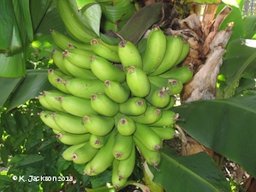 Fig. 8  The 'Dwarf Cavendish', also known as 'Dwarf Chinese', 'Pisang serendah', 'Governor', 'Enano', 'Johnson', first known from China and widely cultivated, especially in the Canary Islands, East Africa and South Africa. The plant is from 4 to 7 feet tall, with broad leaves on short petioles. It is hardy and wind resistant. The fruit is of medium size, of good quality, but thin-skinned and must be handled with care. This cultivar is easily recognized because the male bracts and flowers are not shed. 3 'Dwarf Cavendish' produces large bunches of medium-sized fruit. It is widely planted and better adapted to the cool climate of the subtropics than most other commercial cultivars. 'Dwarf Cavendish' is recommended for south Florida where, in frost-free years and with good care, it produces abundant fruit. One disadvantage to the 'Dwarf Cavendish' is its susceptibility to Black Sigatoka disease. 1 It is highly susceptible to banana bunchy top virus, and chokethroat (impeded bunch emergence) where temperatures below 15 °C (59 °F) occur for extended periods. According to Top Tropicals nursery: "the 'Dwarf Cavendish' produces wonderful tasting fruit as does the others in the Cavendish sub-group. A vigorous grower with wide green leaves. One of the more common grown varieties in the USA. This particular cultivar has found great flavor in Florida as a backyard banana because of its ability to reliably produce fruit with a minimum of care by the homeowner." 31 'Gran Nain' (AAA)
The 'Williams' hybrid is the same as the 'Giant Cavendish'. Also known as ‘Veimama’ (Fiji); ‘Giant Chinese’ (general name); ‘Mons Mari’, ‘Tall Mons Mari’ (Queensland); ‘Williams’, ‘Williams Hybrid’ (Australia and most Pacific islands, including Hawai‘i); ‘Harichal’ (India); ‘Robusta’, ‘Nain Gánt’, ‘Giant Governor’ (West Indies); ‘Nanicó’ (Brazil); ‘Pisang Cina’ (Malaysia); ‘Robusta’, ‘Valery’ (Central America, Jamaica, Hawaii); ‘Taiwan’ (Hawai‘i), ‘Porto Rique’ (Dominica, West Indies); ‘Poyo’ (Guadeloupe); ‘Congo’ (Surinam—see also ‘Pisang Masak Hijau’); ‘Maghrabi’, ‘Williams’ (Egypt); ‘Tumok’ (Philippines). 5 The 'Giant Cavendish' is of uncertain origin, closely resembles the 'Gros Michel', and has replaced the 'Dwarf' in Colombia, Australia, Martinique, in many Hawaiian plantations, and to some extent in Ecuador. It is the commercial banana of Taiwan. The plant reaches 10 to 16 ft (2.7-4.9 m). The pseudostem is splashed with darkbrown, the bunch is long and cylindrical, and the fruits are larger than those of the 'Dwarf' and not as delicate. Male bracts and flowers are shed, leaving a space between the fruits and the terminal bud. 3 Very attractive for its landscaping potential and good wind resistance. The 'Gran Nain' produces very large heads of delicious fruit. It is a very quick ripening. 'Gran Nain' has no problem producing 40-60 lbs of fruit. Prefers pH: 5.8 - 6.2. Not susceptible to the cigar end decay but attacked by the banana corm borer and nematodes. The 'Cavendish' bananas sold by Chiquita Brand are of the 'Grand Nain' cultivar. 'Robusta' (AAA) 'Robusta', very similar to the so-called 'Lacatan', has largely replaced that cultivar in Jamaica and the Windward Islands and the 'Gros Michel' in Central America because it is shorter, thick-stemmed, less subject to wind. It is being grown commercially also in Brazil, eastern Australia, Samoa and Fiji. It is resistant to Panama disease but prone to Sigatoka. 3 'Valery' (AAA) 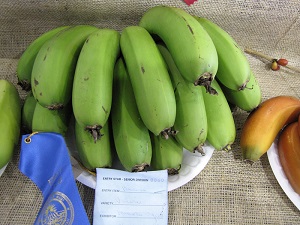 Fig. 12  One of the Cavendish varieties that produces a full sized fruit with a creamy texture. A midsize plant at a height of 10 ft. A triploid 'Cavendish' clone, closely resembles 'Robusta' and some taxonomists believe it may be the same. However, it is being grown as a successor to 'Robusta'. It is already more widely cultivated than 'Lacatan' for export. Not susceptible to the cigar end decay but attacked by the banana corm borer and nematodes. It is resistant to Panama disease but prone to Sigatoka. 3 'Williams' (AAA)
'Williams' is a cultivar of the Giant Cavendish type in the Cavendish subgroup. It is one of the most widely grown cultivars in commercial plantations. 'Williams' is one of the most commonly grown cultivars in the Cavendish subgroup. A medium-height cultivar, it is distinguished by its mostly bare rachis, except for a cluster of bracts above the male bud and very small neutral flowers just below the bunch. 'Williams' is believed to have first appeared as a tall mutant in a Chinese Cavendish plantation in Australia in 1910. It soon started replacing the 'Chinese Cavendish' and, by the 1950s, became the most widely grown cultivar in the country. It represents today 95% of all bananas grown in Australia. It was introduced in Hawai'i in 1953, where it soon replaced 'Chinese Cavendish' in commercial plantations and also became the third most popular backyard banana (after 'Chinese Cavendish' and 'Hawaiian Apple'). The pseudostem of Williams has dark brown, black or red streaks. The rachis is only partly instead of fully clothed, with a long naked section of rachis and a crowded cluster of leaf-like bracts right above the male bud and very small neutral flowers just below the fruit. 13 The colour of the bract internal face is yellowish. Male flowers are whitish with yellow tips. Fruits are 15-23 cm long, slightly curved, and about 5 times as long as broad. Their apex is more bottlenecked than for other Cavendish clones, especially before full maturity. Like other Cavendish, they have a tuft of dead floral relicts at the tip. Williams is a medium to tall plant (2.4-3.7 m). Time from planting to harvest is around 12 months. Williams has a very large, cylindrical bunch, with up to 300 evenly sized and shaped fruits that point evenly upwards. 13 'Double' (AAA+)  Fig. 15 Musa 'Double' banana is an excellent fruiting banana and great for a tropical look in your yard, patio or home. It's a sturdy trunked dwarf banana that will grow to have a central stem five to seven feet tall, relatively dwarf for a banana plant. Its a banana that produces a sweet edible dessert fruit. The reason why these are unusual is because the second fruiting of this banana can produce two or rarely even three blooms and bunches of bananas. It will almost always produce just one bunch on the first fruiting cycle though. These plants look identical to a dwarf Cavendish or Williams hybrid in growth and leaf pattern when young. These are not cold hardy, so they must be brought inside unless you live in zone 9 or 10 for the winter. Sometimes called ‘Mahoe’ or ‘Mahoi’ in error, because it is different from the true ‘Mahoe’ in the Maoli-Popo‘ulu Group, is a ‘Dwarf Chinese’ mutant that produces 2–7 bunches per plant (these are surprisingly common in French Polynesia), but evidently occur wherever this clone is grown. 5 'Bungulan' (AAA) Also known as 'Pisang Masak Hijau' (Malaysia), 'Pisan Ambon Lumut' (Thailand), 'Lacatan' (Jamaica), 'False Lacatan', 'Embun', 'Bungulan' (Hawaii) 'Monte Cristo', 'Giant Fig'. Both the 'Lacatan' Jamaican and cousin Philippine 'Lakatan' produce a similar fruit in shape, texture and flavor. Only the height of the plants differ slightly; the Philippine has more red in the leaf margins and is a little taller. Both produce good sized bunches of fruit that has delicious flavor. W. O. Lessard says: "Both plants take a little longer to make their fruit than most bananas. Both are somewhat cold sensitive but only slightly more so than other bananas. The taste of both fruit is nearly identical. Both plants are resistant to Panama Disease but are susceptible to attack by the banana corm borer and nematodes." Heights (Jamaican12+ft. Philippine 14+ft). 2
'Dwarf and Red Tall" (AAA)
Its official designation is 'Musa acuminata'' (AAA Group) 'Red Dacca'. Known by many names in the world, 'Red Dacca', 'Cuban Red', 'Jamaican Red', ‘Morado’,‘Colorado’, ‘Figue Rouge’, ‘Red’, ‘Claret’ (West Indies) 'Indio', 'Macaboo' (Costa Rica); ‘Red’, ‘Cuban Red’, ‘Pink banana’ (Hawai‘i). This very sweet lady finger fruit is most beautiful. The tall red, with a dark maroon pseudostem can grow14-16 feet, the Dwarf version grows about 8-9 feet in our area. The Red Tall and Dwarf Red are the same except for heights. 'Dwarf Red' is one of many red-skinned banana cultivars, however this one stays short and takes up little space. Most red bananas are much esteemed for good tasting fruit, and this one is no exception. This cultivar also has red pseudostems. The red bananas take longer to ripen than most, it will take up to 24 months to fruit. The banana has a very distinct, robust flavor that makes it well worth the wait. This red banana's skin turns sunset colors through the ripening process from yellow-green to orange then to red. The skin should be almost very dark red before it is ripe enough to eat. The thick leaves of 'Dwarf Red' Banana work well for wrapping and grilling meats. In his book, W. O. Lessard talks about the dwarf cultivar as "a very desirable plant. It produces consistently and stands up to the wind well. The fruit is of top quality, sweet and moist with a buttery consistency." 2 'Green Red' (AAA) W. O. Lessard also talks about a common mutation of the 'Red' (or 'Macaboo' as he refers to this cultivar) to a green plant. He says "when that happens, the 'Macaboo' will produce green fruit and larger heads. This mutation is not gradual but happens in one generation. When this happens the green banana is called a 'Green Red' or 'Green Macaboo'. The mutation is stable and will stay green. The fruit is still just as delicious as the 'Red Macaboo' but is grows to be a little fatter." 2 AA. AAA. AAB. AB. ABB. BB. BBB. AAAA. AABB. AAAB. ABBB
The AAB genome group comprises subgroups and cultivars that have two sets of chromosomes donated by Musa acuminata and one by Musa balbisiana, based on the nomenclature system developed by Norman Simmonds and Kenneth Shepherd. 5 Triploid cultivars of Musa × paradisiaca. This group contains the Plantain subgroup, composed of "true" plantains or African Plantains - who's centre of diversity is Central and West Africa, where a large number of cultivars were domesticated following the introduction of ancestral Plantains from Asia, possibly 2000-3000 years ago. 4 The Iholena and Maoli-Pōpō‘ulu subgroups together form the “Pacific plantains,” the principal Polynesian basic types of bananas from which many similar varieties evolved on different Pacific archipelagos over thousands of years. These plants are between a plantain and a banana and can either be eaten fresh or cooked. They are more cold sensitive than other bananas. Their fruit matures more quickly, seven weeks after the flower has opened. Iholena types are graceful plants. 5 Their most outstanding characteristics are: a) new, unfolding (cigar) leaves with striking mauve or coppery undersides; b) fruit pointed at both ends with salmon-colored flesh; c) fruit arranged loosely and at right angles on the bunch; and d) male flowers with long, lavender stamens. Iholenas are characterized by pale yellow-green immature fruits from earliest development. Plantains are hybrid bananas in which the male flowering axis is either degenerated, lacking, or possesses relicts of male flowers. Plantains are always cooked before consumption and are higher in starch than bananas. The two groups of plantains, French and Horn, produce fewer fruit per plant than sweet bananas. The groups differ in whether the male parts of the inflorescence are persistent or absent. 5 Iholena subgroup Maoli-Popoulu subgroup Mysore subgroup Plantain subgroup Pome subgroup Silk subgroup
Iholena is the name of a subgroup of cooking bananas in the AAB genome group. The subgroup was domesticated in the Pacific region and is named after the Hawaiian name of its most representative cultivar. The name refers to the colour of the fruit pulp, iho meaning core or heart and lena meaning yellow or yellow-orange. The colour of Iholena fruits suggests that are high in pro-vitamin A carotenoids. Iholena and Maoli-Popoulu bananas, which were also domesticated in the Pacific region, are loosely known as Pacific plantains because of their close relationship with African plantains. They have become increasingly rare in the Pacific, but are still grown in Samoa, Cook Islands, French Polynesia (where they are called Orea for 'yellow colour like turmeric'), Vanuatu, New Guinea, Tonga and perhaps other places. In Hawaii, they are mostly found growing wild in highland forests. 14 The underside of the cigar leaf is mauve, silvery, coppery, reddish or bronze-coloured, not to be confused with Mysore bananas, which also have pink on the underside of their leaves. The colour normally fades within a week but may persist for months. Some cultivars have this colour on the undersides of most leaves. The petiole has erect or slightly incurved margins. 14 Leaf habit is drooping, compared to the Maoli-Popoulus, which have more erect leaves. The rachis is typically bare. The bunch is small to medium-sized. The fruit turn yellow early, when the pulp is still firm. At that stage, the fruit may require another 2 to 3 weeks on the plant to reach maturity. This trait may have contributed to their neglect. The male flowers are generally yellowish or whitish, with hardly any pink on the compound tepal. The stamens are long, curled and the colour of lavander. The free tepal is translucent with a small apicula. 14 'Gerei Langi' (AAB)
'Gerei Langi' is the name given to a type of Iholena banana on the island of Guadalcanal in the Solomon Islands. It is also known as 'Kolale'. It was reported by Gabriel Sachter-Smith, who observed it near the capital Honiara in 2011. As with other Iholenas, the underside of the cigar leaf is coloured, the peduncle is red and the fruit jut out perpendicular to the rachis. The margins of the petiole canal are pink. 15 'Iholena Lele' (AAB)
The fruit apex is typically lengthily pointed with distinct pleats. The medium-long fruits (13-15 cm) are tapered at both ends. The pulp is a bright salmon-pink. 16 Red and White Iholenes, both forms of 'Ihlena Lele', are Polynesian banana-plantain crosses that ripen faster than any other cultivar. The stalk and leaf undersides of Red Ilohene are a beautiful burgundy color. The fruit emerges yellow and in 7 weeks is salmon colored and ready for harvest. The flesh is orange, fairly dry, and excellent for eating fresh or use in cooking. 2 Back to AAB Genome
'Maoli' bananas are indigenous to the Pacific region. They were originally classified in their own subgroup (often designated as 'Maia Maoli', Maia being the Hawaiian term for bananas), but are increasingly classified together with the Popoulu bananas in the 'Maoli-Popoulu' subgroup. 19 'Maoli' (AAB) 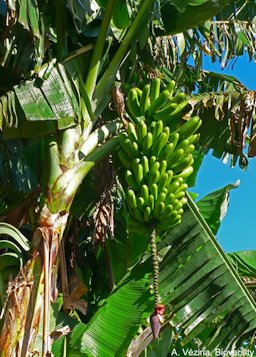 Fig. 26  'Maoli' bananas have a distinctive sausage shape. Indigenous to the Pacific region, they are believed to have been domesticated in the New Guinea area, from where they were introduced to many Pacific islands by Polynesian settlers. The sausage-shape fruits are straight or slightly curved. They are 3-4 times as long as they are wide. The fruit tip is rounded and well-filled but not bulging. When fully ripe, the pulp colour is usually a rich yellow-orange. 19 'Eleele' (AAB) ‘Ele‘ele’ (lit. “black-black”) Other common names: ‘Black Hawaiian’, ‘Hawaiian Black Banana’ (Florida) An attractive Hawaiian banana, this is extremely uncommon, preferring streambeds and well-watered forested areas. It is immediately recognizable by its shiny, blackish- burgundy trunk, leaf stalks, and midribs (especially in wild, shaded locales). Its fruit is long, meaty, and delicious fried. Its variants, ‘Poni’ (“purple”), ‘Hinupua‘a’ (“shiny like hog grease”) and ‘Puna’ (region on the island of Hawai‘i) are less black overall. 5 ''Ae Ae'' (AAB) 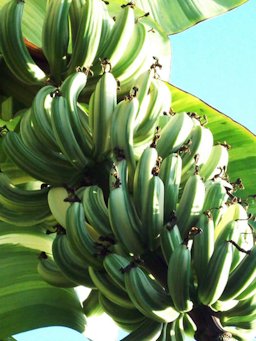 Fig. 27  ‘Manini’ (lit. “striped surgeon fish”), ‘Koa‘e’ (referring to the bold, striped plumage of tropical birds in juvenile plumage). Other common names: ‘Aeae’ (lit. “hair prematurely graying”), 'Sacred Banana', ‘Hawaiian Variegated’ (Hawai‘i), ‘Manini’, 'AE AE', 'Vittata'. The 'Manini' is a Hawaiian cultivar with green and white variegation that covers the entire plant: leaves, leaf stalks (petioles), immature and ripe fruit, even the male and female flowers. The achlorophyllous tissues have a tendency to sunburn. Grows to height of 20–23 feet, prefers acid soil (<pH 6), will not tolerate neutral or basic soils, and thrives best in cloudy or lightly shaded areas. The fruit are best cooked, but are palatable raw when fully ripe. 5 In his book, W. O. Lessard writes: "The 'Ae Ae' is one of the most beautiful plants I have ever seen. The variegated green and white plant grows to 16 to 20 feet tall with wide leaves spreading from six to seven feet from the pseudostem. The fruit, about six to eight inches long, are always variegated lengthwise giving them the appearance of being striped. As the fruit ripens the green stripes turn dark yellow while the white stripes turn light yellow maintaining the striped appearance. The fruit pulp is a light orange color. Its lower moisture content makes it closer to a plantain than to a dessert banana. It may be eaten ripe at a deep yellow color or cooked when it is a little less ripe or unripe. The plant grows rather slowly because the white areas of the leaves are unable to photosynthesize and so the leaves are not fully functional. When suckers are taken from the 'Ae Ae' for planting they should be at least 50% green to assure a strong plant. 2 Back to AAB Genome 'Popoulu' (AAB)  Fig. 28  Of Polynesian origin, this slender beauty grows to 14' and produces blunt shaped fruits similar to the 'Hua Moa'. The leaves are burgundy beneath, and this color matches its red/pink pseudostem and petioles. Also known as 'Hawaiian banana 'Popoulu', Plantain 'Popoulou', 'Banane à chair rouge','Banane de Nouvelle Calédonie' 'Huamoa' (AAB)
'Hua moa' (AAB) also known as ‘Huamoa’ or ‘Moa’ (lit. “chicken” or “goose egg”), 'Hawaiano' (name imported from Hawai‘i) is a leading cultivar in south Florida despite its susceptibility to Panama disease and poor cold tolerance. The fruit can be eaten fresh or cooked and makes excellent fried green and smashed bananas. 'Hua moa' requires intensive care and is recommended only for planting with disease-free material in warm, protected sites free of Panama disease. 1 Grows to 10-15 ft tall. Produces small to medium bunches of very plump fruit to 4" in diameter, roundish with golden-yellow skin and pinkish yellow-orange flesh. Very sweet flavor. Fruit may be eaten fresh or cooked. Likes filtered sun with ample moisture. World's best cooking banana. Should be harvested before it ripens on the plant as it will split before it turns color. The 'Haa Haa', one of the same group, grows to 6-7 feet. A striking plant which bears medium bunches of delicious fruit with orange flesh. This clone occasionally forms only a few, extraordinarily large fruit on the bunch; otherwise, the bunch is normal, but with fruit ranging from small eggs to 20 cm (8 in) in length by 6 cm (2.5 in) in diameter. The Samoan ‘Fa‘i Samoa Fua Moa’ is extremely similar and has a name with the same meaning. 5 Back to AAB Genome
'Mysore' (AAB) 'Mysore', also known as 'Fillbasket' and 'Poovan', is the most important banana type of India, constituting 70% of the total crop. Other common names: ‘Liganimarama’ (Fiji); ‘Misiluki Mysore', also known as 'Pisang Keling', 'Thousand Grain', 'Fillbasket'. It is sparingly grown in Malaya, Thailand, Ceylon and Burma. It is thought to have been introduced into Dominice in 1900 but the only place where it is of any importance in the New World is Trinidad where it is cultivated as shade for cacao. The plant is large and vigorous, immune to Panama disease and nearly so to Sigatoka; very hardy and drought tolerant. It bears large, compact bunches of medium sized, plump, thin skinned, attractive, bright yellow fruits of subacid flavor. 3 A very ornamental plant which produces heavy bunches of sweet flavorful bananas. A lady finger variety it has a tall and multicolored reddish purple trunk, leaf petioles and underside of the leaf make this a beautiful banana. 20 months until harvest. Height 15' to 18'. 5 Back to AAB Genome
Synonym: M. discolor Horan. This diverse group of “true” plantains is not to be confused with Pacific plantains or with other cooking bananas with an ABB genome. Plantain fruit are often longer and far more pointed. They comprise 21% of annual Musa production worldwide, assuming their greatest dietary importance in West Africa and Latin America. In these regions they are a major source of dietary carbohydrates. Four subsets plantains are known only in India, Africa, Egypt, and the Americas; 'French', 'French horn', 'False horn' and 'Horn'. 5 "True" plantains are a group of cultivated varieties (cultivars) of the genus Musa (bananas and plantains) placed in the Plantain subgroup of the AAB genome group. The term "plantain" is also used in other senses. It can refer to all the banana cultivars which are normally eaten after cooking, rather than raw, for which see cooking plantain, or to members of some other subgroups of Musa cultivars, such as the Pacific plantains. 4 The Plantain subgroup refers to a set of cooking bananas that display a wide range of morphological variability. The triploid genome of these bananas, shorthanded AAB, denotes that they are hybrids of Musa acuminata and Musa balbisiana in a proportion of roughly two to one. Even though bananas originate from the Asia-Pacific region, the diversity of Plantains is highest in Africa, especially West and Central Africa. The term plantain is often used ambiguously to refer to all types of cooking bananas or to suggest that plantains are not bananas, as in the expression bananas and plantains. In Spanish, plátano, from which is derived the term plantain, is often used to refer to all types of bananas. 20 The Plaintain subgroup also has dwarf and semi-dwarf cultivars. Dwarfism is characterized by a lower leaf ratio (length/width) than the one measured on giant, medium and small types. The leaves of dwarf types are also more erect. Plantains requires a warm and humid climate with no major oscillations. They will generally not survive a dry season that lasts more than 3 months and temperatures below 10ºC for more than a few nights. Most Plantains exhibit strong apical dominance, which suppresses sucker growth until after bunch emergence. They then tend to remain small because of competition with each other. The shallow and poorly ramified root system of Plantains also makes them susceptible to 'high mat', the tendency of the plant base to grow out of the soil. 20 Norman Simmonds recognized two types of Plantains distinguished by the presence of the male bud (French) or its absence/ degeneration (Horn). Two types were later recognized: False Horn and French Horn. 20 French Plantain cultivars: 'Obino l'Ewai' (Nigeria), 'Nendran' (India), 'Dominico' (Colombia) French Horn cultivars: 'Batard' (Cameroon), 'Mbang Okon' (Nigeria) False Horn cultivars: 'Agbagda' and 'Orishele' (Nigeria), 'Dominico-Harton' (Colombia) Horn Plantain cultivars: 'Ishitim' (Nigeria), 'Pisang Tandok' (Malaysia) ‘French’ 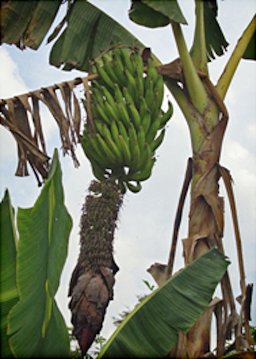 Fig. 31 Synonym: M. paradisiaca L., M. paradisiaca L. var. viridis De Wild., M. purpureo-tomentosa De Wild., M. × paradisiaca auct. non L. Many ill-defined forms of French plantain exist, some overlapping with the next two clonal clusters: ‘Green French’ (also known as 'Banana Creole', 'Banane Rouge', 'Banane Noire', 'Banane Puce', 'Banane Cent Livres', 'Pisang rastali', 'Pisang raja sereh' in Indonesia), ‘Pink French’, ‘Wine’, ‘Black French’, ‘Tiger’ (also known as French plantain 'Tiger', 'Banane Puce') and ‘Giant’. Some common cultivars: ‘Obino l’Ewai’ (Nigeria); ‘Njock Kon’, ‘Bobby Tannap’ (Cameroon); ‘Nendran’ (India); ‘Dominico’ (Colombia); ‘Tarapuakanio’ (Cook Is.). French Plantains are called 'Plátano Hembra' (Central America), 'Congo' (Puerto Rico) and 'Banane Blanche' (French West Indies). French plantains are known only in India, Africa, Egypt, and the Americas. 5 French Plantains have persistent bracts on the rachis and a large male bud. French plantains are commonly subdivided into size categories: giant, medium, small. The medium and small French types produce more suckers than the giant French types. Since the height and girth of the pseudostem vary with the environmental conditions, the number of leaves produced from planting to flowering is used to determine the size class: giant (more than 40 leaves); medium (between 32 and 38 leaves); and small (less than 30 leaves). Most of the French Plantains are giant types characterized by large bunches that contain many hands and relatively small fruits. These cultivars have a long vegetative cycle and are susceptible to toppling in windy conditions. 20 'French Horn' (AAB) 
Fig. 32  Some common cultivars: ‘Mbang Okon’ (Nigeria); and ‘3 Vert’ (Cameroon). The male bud of both French Horn and False Horn types degenerates at maturity. French Horn plantains have a high number of neutral flowers, whereas False Horn plantains retains only a few neutral flowers. Both types have large fingers, but the bunch of French Horn plantains is dense. The plant size categories are also different. For example, a medium French Horn is taller than a medium False Horn. 5,20 This plantain is much favored in Ecuador and the West Indies; used as a staple in their diets. The slightly curved fruit is large and delicious, comparable to the commercial plantains that we know and adore. Resistant to Panama Disease but not to the corm borer and nematodes. Height 12-14 feet. ‘False Horn’ (AAB)  Fig. 33 Synonym: M. decrescens de Briey. Some common cultivars: ‘Agbagba’ and ‘Orishele’ (Nigeria); ‘Dominico-Hartón’ (Colombia); ‘Cuerno’ (Central America); ‘Barragante’ (Ecuador) ‘Batard’. 5 The male bud of both 'French Horn' and 'False Horn' types degenerates at maturity. 'French Horn' plantains have a high number of neutral flowers, whereas 'False Horn' plantains retains only a few neutral flowers. Both types have large fingers, but the bunch of 'French Horn' plantains is dense. The plant size categories are also different. For example, a medium 'French Horn' is taller than a medium 'False Horn'. 20 ‘Horn’ (AAB) 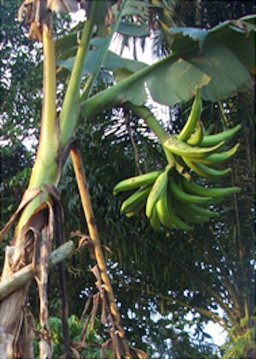 Fig. 34 Synonyms: M. corniculata Rumphias, M. corniculata Lour., M. emasculata de Briey ex De Wild., M. protractorachis De Wild. Some common cultivars: 'Ishitim' (Nigeria); 'Pisang Tandok' (Malaysia). 5 Horn Plantains typically produce very few fruit spread over one to five hands (exceptionally eight to ten). The rachis ends after the last hand. No male bud is produced. Horn Plantains are called 'Plátano Macho' in Central America. 20 'African Rhino Horn' (AAB) 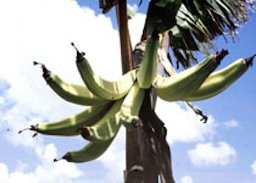 Fig. 35 Its official designation is 'Musa acuminata × balbisiana'' (AAB Group) 'African Rhino Horn. 'Rhino Horn' bananas, also called 'Rhino Horn' plantains or 'African Rhino Horn', are hybrid banana cultivars from Africa. 'Rhino Horn' banana plants can grow to a height of 12 to 20 feet. The pseudostem and leaves are dappled red. It produces strongly curved and elongated edible bananas which can grow to a length of two feet, making them have the longest fruits among banana cultivars. reaching up to 2 feet in length, though they normally only reach lengths of 12 to 14 inches. They produce two to four hands per bunch. Fruits of the, 'Rhino Horn' bananas can be eaten raw or cooked. They are also cultivated as ornamental plants for their attractive coloration. 21 Back to AAB Genome
The Pome subgroup, prominent in places such as Brazil, India, Hawai‘i, Cameroon, and Australia, is characterized by fruit stalks that emerge at an angle until the fruit develop, whereafter the rachis falls vertically. Fruit are distinctly “beaked” or “bottle-nosed” and have a particularly sub-acid or “apple-like” taste. Because of this piquant flavor, various cultivars have been named “apple” thereby confusing these cultivars with ‘Silk’, the more widely recognized “apple” banana. 22 Pome cultivars are common in India and Brazil (where it is known as Prata). In Australia, the Pome cultivar 'Pacha Nadan' is marketed under the name Lady's Finger. The fruit bunch develops at an angle while the rachis points vertically down. The fruit apex is often bottle-necked. 5 'Pome' (AAB) Other names or similar clones: ‘Apple', ‘Tall Apple' 'Pome (Canary Islands); ‘Brazilian’ (Florida); ‘Lady’s Finger’ (Queensland); ‘Brazilian Tall’ (Hawai‘i); ‘Pisang Kelat Jambi’ (Malaysia) and 'Prata'. These plants are sturdy, vigorous, highly productive and can be quite tall. In Hawai‘i and French Polynesia, local Pome-type clones are favored above all others. They are the most common home-grown and island-grown commercial. 5 It is a tall-growing clone tolerant to cool conditions with small, sweet fruit. However, because of its susceptibility to wind damage and Panama disease, it should only be planted in wind protected areas and land not previously infested with this disease. 1 Back to AAB Genome
The Silk subgroup comprises cultivars that produce sweet-acid fruits whose flavour is reminiscent of apples, hence the use of the names Apple, Manzana and Figue pomme to refer to these bananas. Their susceptibility to Fusarium wilt has led to a decline in their importance. The peel of ripe fruits splits easily. The skin at the upper surface of the pedicel tends to break transversely, so that the fruit falls. Silk cultivars are often confused with those in the Pome subgroup. They differ in having a more slender male bud, narrower and more pointed bracts and more numerous male flowers. 23 'Silk' (AAB) It's full name is Musa acuminata × M. balbisiana (AAB Group) 'Silk'. There are numerous common cultivars named 'Apple'. The most common 'Apple' in south Florida is an AAB. It is also called 'Silk,' 'Manzana,' and 'Manzano', 'Apple banana', 'Sugar banana' (Australia), 'Amorosa', ''Manzana', 'Manzano''Lady Finger' (Hawaii); 'Letondal', 'Latundan', 'Tordan, ' Tundan'. 'Turdan', 'Cantong'. 'Amorosa'. 'Katungal' (Philippines); 'Silk Fig', 'Manzana', 'Manzano'. 'Figue Pomme', 'Apple' (West Indies). 5 It is a dessert-type banana with a pleasant, sub-acid flavor when fully ripe and is common in the Caribbean. The plant is medium-sized and susceptible to Sigatoka and Panama disease. It is only recommended for home landscape planting in Panama disease-free sites with disease-free planting material. 1 The plump bananas are 4 to 6 in long, slightly curved; astringent when unripe but pleasantly sub-acid when fully ripe; and apple scented. If left on the bunch until fully developed, the thin skin splits lengthwise and breaks at the stem end causing the fruit to fall, but it is firm and keeps well on hand in the home. 3 The fruit peel splits and the flesh is white when ripe, and is astringent when not. It has declined in importance there and elsewhere due to its pronounced susceptibility to Panama disease. In Hawai‘i, it is found almost exclusively within Filipino communities, who perhaps introduced it to Hawai‘i, bringing with it their Philippine name, ‘Amorosa’. Grown in poor soils, especially those deficient in calcium and boron, a common occurrence in tropical and subtropical regions, the fruit’s flesh becomes hard. 5 'Latundan' (AAB) 'Latundan' is a popular dessert banana in the Philippines. 'Tundan' (Philippines), 'Pisang Rastali' (Malaysia), 'Pisang Raja Sereh' (Indonesia), 'Kluai Nam' (Thailand), 'Chuoi Goong' (Vietnam). 24 'Thousand Finger' (AAB) 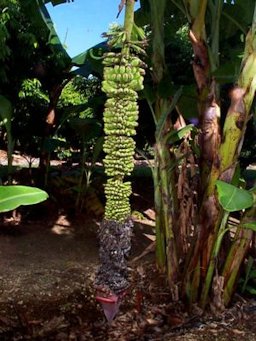
Fig. 37 Other common names: ‘Pisang Seribu’ (Malaysia); ‘Kluai Roi Wi’ (Thailand), ‘Thousand fingers' (Florida), 'Pisang Kelat' (Malaysia). As the name implies, this variety will produce as many as 1000 bananas. This plant only produces female flowers and will continue to produce fruit until the stalk reaches the ground. The fruit is small, with a sweet pleasant flavor. Zones 8B-10. 30 In the 'Complete Book of Bananas', W. O. Lessard explains: "The reason for this unusual fruiting characteristic is that the banana flowers in a sequence that is reversed from other bananas. There are no male flowers produced and the first things to emerge from the opening flower are the hands of hermaphroditic flowers. About three or four hands of these are made and then the plant begins to unfold female flowers with attached ovaries. The flower stem of a well fertilized plant will continue to make female flowers and fruit until the plant dies or the flower bud is broken off. Usually that is the only way to make the bottom fruit size up. It is possible for the fruit on the top of the head to be ripening while the flower on the bottom of the head is still opening female flowers. If the plant has been fertilized well and supported there is no telling how long the stem of fruit would get. Eight or nine feet is certainly possible. Because of its unusual flowering characteristic the flowering cycle lasts up to five months and the raceme just keeps getting longer." 2 'Raja Puri' (AAB)
An outstanding variety which can handle the wind and cold. It quickly produces a medium bunch of sweet, high quality fruit. Mature height is 8' to 10'. A very popular sturdy plant originating in India and becoming a favorite around the world. Due to the rapid growth and delicious taste of these 3/4 size fruit as well as cool tolerance they have won the hearts (and taste buds) of thousands. Nice and sweet Desert banana. Reaches about 10 feet in height. Color of the fruit is orange/yellow. 31 W. O. Lessard writes: "If there ever was a banana that deserved the name "bullet proof' it must be the 'Raja Puri'. It is the best plant to grow in marginal areas or where a grower does not intend to put much care into the cultivation of a banana. This is a dwarfed plant that grows to seven or eight feet before fruiting. It is totally green having no red coloring at all. The plant has a very thick stem and stands up very well to the wind. I have never seen one blow over even when carrying large large heads of fruit. The 'Raja Puri' is immune to Panama Disease and is not attacked by nematodes or corm borers. It must have some sort of natural repellent that wards off most pests because I have never seen it bothered even when I knew there were nematodes and corm borers in the vicinity." 2 'Pisang Raja' (AAB) Also known as 'Grindy'. 'Pisang Raja' is a sturdy plant, tolerating cold and wind, growing to 20 ft. It is one of the most delicious bananas and has orange-fleshed, slightly fuzzy fruit that are between 6 to7 inches long. It is the most productive of the orange-fleshed bananas. Back to AAB Genome AA. AAA. AAB. AB. ABB. BB. BBB. AAAA. AABB. AAAB. ABBB
The ABB genome group comprises cultivars that have three sets of chromosomes, one donated by Musa acuminata and two by Musa balbisiana. These cultivars produce relatively starchy fruit, primarily used for cooking. The plants are drought resistant and generally resist the Sigatoka leaf spot diseases.
These are vigorous clones. They produce widely spaced, large, angular, straight fruit that have long peduncles; usually, only four to seven hands are produced on a bunch. The various cultivars are distinguished by stature, bunch size and the fruit skin (green, silver, or waxy). They are susceptible to race 2 of Panama disease and Moko disease. 5 'Bluggoe' (ABB)
'Square Cooker', 'Mondolphin' (Australia), 'Hpi Gyan' (Burma/Myanmar), 'Tarua Matie' (Cook Islands), 'Burro', 'Orinoco' (Cuba), 'Jamani' (Fiji), 'Largo' (Hawai'i), 'Nalla Bontha (India), 'Horse Plantain' (Jamaica, Dominican Republic, Trinidad and Tobago), 'Pisang Batu' (Java),'Poro'ini', 'Poro'ini Pa'afa'afa'a', 'Poro'ini Hima'a umu', 'Largo' (French Polynesia). 'Pisang Abu Keling' (Malaysia), 'Matavia' (Philippines), 'Fa'i Pata Samoa', 'Puataelo' (Samoa), 'Mondan' (Sri Lanka), 'Kluai Som' (Thailand), 'Pata Tonga' (Tonga), 'Chuoi Ngop Lun' (Vietnam), 'Bluggoe', 'Whitehouse Plantain', 'Chamaluco', 'Poteua', 'Cacambou', 'Moko', 'Buccament', 'Mafoubay' (West Indies), 'Mkojosi', 'Bokoboko', 'Kproboi', 'Muscat', "punda', 'Kidhozi', 'Kivuvi' (East Africa), 'Burro', 'Chato', 'Cachaco', 'Cuatrofilos', 'Largo', 'Majoncho', 'Apple Plantain', 'Horse Banana', 'Hog Banana' (Americas). 10 'Bluggoe' is a cooking banana especially resistant to Panama disease and Sigatoka. This medium tall, sturdy plant, is particularly hardy. The bunch consists of only a few hands of very thick, 3 angled fruits about 6 in long. The flesh has a salmon tint, is firm, edible raw when fully ripe but much better cooked fried, baked or otherwise, as are plantains. 3 'Blue Java' (ABB)
It's accepted name is 'Musa acuminata × Musa balbisiana'' (ABB Group) 'Blue Java'. Other names: ‘Ice Cream’ (Hawai‘i, Florida); ‘Java Blue’, ‘Vata’, ‘Pata’ (Fiji,); ‘Blue Java’, ‘Blue Lubin’(Australia); ‘Ash Plantain’ (Sri Lanka); ‘Ney Mannan’ (India); 'Pata Hina', 'Pata Lahelahe' (Tonga); 'Fa'i Pata Sina', 'Pata papalagi' (Samoa); 'Tarua Teatea' (Cook Is.); 'Dukuru' (Pohnpei, Federated States of Micronesia). The fruit is named for its flavor and texture, sweet and smooth. When fully ripe, the flesh can be eaten with a spoon. Externally, the fruit is colored a beautiful silver-green, due to a heavy coating of wax. 5 'Blue Java' bananas can grow to a height of 15 feet to 20 feet. They are cold tolerant and like tall bananas of the ABB Group, are wind resistant because of their strong pseudostems and root systems. The leaves are silvery green in color. The fruit bunches are small, bearing seven to nine hands. The fruit are 7 to 9 inches in length and exhibit a characteristic silvery blue color when unripe. The fruit turn a pale yellow when ripe, with white creamy flesh. They bloom around 15 to 24 months after planting and can be harvested after 115 to 150 days. 'Blue Java' bananas are popular bananas that can be eaten fresh or cooked. They are known for their fragrant fruit which taste like vanilla custard. The fruit goes well with ice cream. They are also popular as ornamentals and shade plants for their unusual blue coloration, large size, and tolerance to temperate climates. 28
'Pelipita' (ABB)  Fig. 47 Also known as ‘Pilipia’ (Philippines); 'Saba', 'Cardaba','Papaya banana', 'Pawpaw banana', Philippines cooking banana', 'Bali cooking banana'. 'Pelipita' is one of the most important commercial varieties of plantain, according to Purdue University. The pelipita plantain is resistant to black Sigatoka. It is also favored as a commercial plantain variety because it is resistant to Panama disease, also known as banana wilt. Purdue University describes this disease as a plague that has adversely affected banana plantations in Central America, the Canary Islands and Colombia. This clone tolerates Moko disease, due to its persistent bracts. It was offered as a resistant replacement for ‘Bluggoe’ in the Americas where that clone was decimated by Moko disease.
'Pisang Awak’ (ABB) 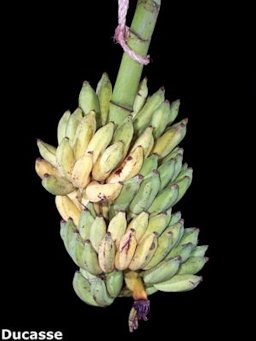 Fig. 48 More Images for 'Pisang Awak' 'Pisang Awak' 'Ducasse' (Australia), 'Yakhine' (Burma/Myanmar), 'Vietnamita' (Cuba), 'Paradaika' (Egypt), 'Nyeupe' (Kenya), 'Karpuravalli', 'Pey Kunnan', 'Kostha Bontha', 'Monohar', 'Sail Kola' (India), 'Pisang Klotok' (Indonesia), 'Pisang Awak' (Malaysia), 'Katali' (Philippines), 'Gisubi' (Rwanda), 'Kluai Nam Wa' (Thailand), 'Chuoi Tay' (Vietnam), 'Kayinja' (East Africa), 'Fougamou'. 25 This is the most widely disseminated ABB cultivar; 70% of all bananas that are grown in Thailand are of this clone. It is vigorous and tolerates adverse conditions, especially drought, but is susceptible to race 1 of Panama disease. 5 This delicious ladyfinger type dessert banana has been described as having the tastiest, sweetest, highest quality fruit. It grows rapidly even in cool areas (hardy zones 9-10). The sweet, thin-skinned bananas mature very quickly, even when the flower appears somewhat late in the season. In addition, because it's a dwarf, it makes a great container banana. It is drought resistant and vigorous. 27
Saba is the name given in the Philippines to a cooking banana belonging to the Saba subgroup. Its classification at the genome group level is still disputed years after it was suggested to be a triploid of Musa balbisiana origin only. Whereas some molecular analyses support a BBB genome group, morphological traits characteristic of Musa acuminata, such as curly bracts, place it among the ABB. On the other hand, if backcrossing with wild relatives was more common than previously thought, it is possible that backcrosses with M. balbisiana might have led to the substitution of M. acuminata genes by M. balbisiana ones, leaving only remnants of the original M. acuminata genome. 26 'Praying Hands' (ABB) 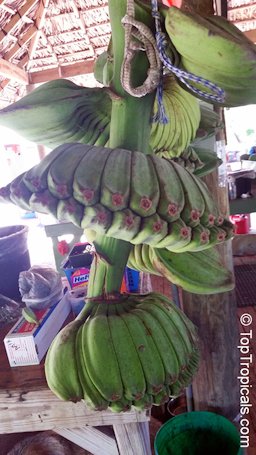 Fig. 49  'Praying Hands' (Florida); 'Inabaniko', 'Uht Kapakap' (Pohnpei); 'Ripping' (Philippines) 5 Musa 'Praying Hands' produces perhaps the most unusual and distinctive of all banana fruits. Two adjacent hands of bananas are fused, giving the appearance of praying hands. The fruits are delicious when ripe, containing a hint of vanilla flavor. When totally ripe, individual bananas can be carefully separated from each other. 'Praying Hands' has good wind resistance. 'Saba' (ABB)
'Saba' (Philippines); 'Pisang Kepok' (Indonesia); 'Pisang Nipah' (Malaysia); 'Kluai Hin' (Thailand). The male bud of this clone is a popular vegetable in the Philippines. 5 Saba banana is a triploid hybrid (ABB) banana cultivar originating from the Philippines. It is primarily a cooking banana though it can also be eaten raw. It is one of the most important banana varieties in Philippine cuisine. It is also sometimes known as the Cardaba banana, though the latter name may be more correctly applied to a very similar cultivar also classified within the Saba subgroup. Saba bananas have very large, robust pseudostems that can reach heights of 20 to 30 ft (6.1 to 9.1 m). The trunk can reach diameters of 3 ft (0.91 m). The trunk and leaves are dark blue-green in color. Like all bananas, each pseudostem flowers and bears fruits only once before dying. Each mat bears about eight suckers. The fruits become ready for harvesting 150 to 180 days after flowering, longer than other banana varieties. Each plant has a potential yield of 26 to 38 kg (57 to 84 lb) per bunch. There are typically 16 hands per bunch, with each hand having 12 to 20 fingers. Saba bananas grow best in well-drained fertile soils with full sun exposure. They inherit most of the characteristics of Musa balbisiana, making them tolerant of dry soil and colder conditions of temperate climates. They require minimum rainfall and can survive long dry seasons as long as adequate irrigation is provided. However, their fruits may not ripen under such conditions. They also have good resistance against Sigatoka leaf spot diseases. The fruits are 8 to 13 cm (3.1 to 5.1 in) long and 2.5 to 5.5 cm (0.98 to 2.17 in) in diameter. Depending on the ripeness, the fruits are distinctively squarish and angular. The flesh is white and starchy, making it ideal for cooking. They are usually harvested while still green after 150 to 180 days after planting, especially if they are to be transported over long distances. 29 'Kru" (ABB) In his book "The complete Book on Bananas", Mr. Lessard says: "This rare variety was imported from the jungles of New Guinea, where it has become extinct. "The Kru is of moderate height growing to about 12 feet. It is somewhat slender and quite cold sensitive being damaged at about 35-40 degrees. The pseudostem is very pink and the fruit are red although not as dark red as the fruit of the Macaboo. The heads of fruit are not large weighing twenty to thirty pounds. They are of a much different shape than those described in The Reds. The form of the Kru is close to that of the Orinoco or Ice Cream banana being a fruit with angular edges, shorter than the Orinoco growing to only five or six inches long, however, the raceme is not as closely packed as the Ice Cream banana. There is little curvature to the fruit. The taste is delicious, perhaps even the most delicious of all bananas. The pink pseudostem gives the Kru the look of a Jamaican Red or Macaboo but on close inspection the trunk is a lighter red and the bottom side of the Kru leaves have an indefinite red margin of two to three inches along the edge. Like the Macaboo the midrib of the leaf is red". 2 AA. AAA. AAB. AB. ABB. BB. BBB. AAAA. AABB. AAAB. ABBB
There are no natural AAAA and very few natural AAAB, AABB, and ABBB bananas, none of which are important. Tetraploids that are most common in cultivation are products of the breeding programs. In general, they have resulted from crosses between triploid female and diploid male parents. A few promising varieties are found in cultivation (including some Pacific islands) in those areas where banana diseases are rampant. Most notable among the bred tetraploids are those from the FHIA program in Honduras: dessert AAAA, ‘FHIA-02’ (aka ‘Mona Lisa’), ‘FHIA-17’ and ‘FHIA-23’; dessert AAAB, ‘FHIA-01’ (aka ‘Goldfinger’) and cooking and dessert ‘FHIA-18’; plantain-like AAAB, ‘FHIA-20’ and ‘FHIA-21’; and cooking or dessert AABB, ‘FHIA-03’. 5 HONDURAN AGRICULTURAL RESEARCH FOUNDATION (FHIA) The overall objective of the program is to develop hybrids of bananas and plantains that are resistant to the main diseases and insects of economical importance. The resulting hybrids are also screened to determine the best ones that have the ability to prosper under adverse growth conditions. Identification and Characterization Guide to FHIA Banana and Plantain Hybrids, Biodiversity International pdf 'Goldfinger' FHIA-01 (AAAB)
The Goldfinger banana (FHIA-01) is a banana cultivar developed in Honduras. The cultivar, developed at the Honduran Foundation for Agricultural Research (FHIA) by a team of scientists led by Phillip Rowe and Franklin Rosales, has been bred to be pest-resistant (specifically against the black sigatoka) and crop-yielding. 32 'FHIA-01' is a synthetic hybrid dessert banana that was released by FHIA in 1988. It was developed from a Dwarf Pome and another synthetic hybrid. 'FHIA-01' plants are cold- and wind-tolerant and produce higher quality fruits in sub-tropical, than tropical, conditions. 'FHIA-01' is tolerant/resistant to Fusarium wilt and black leaf streak (black Sigatoka) and susceptible to Sigatoka leaf spot (yellow Sigatoka) and nematodes. 'FHIA-01' has been widely distributed for subsistence and commercial cultivation. 'FHIA-01' is also marketed under the name 'Goldfinger'. 6 The Goldfinger takes longer than other banana varieties to mature, but is more resistant to cold, wind and pestilence. It grows to 4.3 meters (14 feet). Though the Goldfinger is edible while still green (in the form of chips, for instance), it is most appealing to Western markets when ripe. In this form, the Goldfinger's stated aim is to replace the much more popular Cavendish banana, which is essentially the sole dessert banana sold in North American and European markets. Since its launch, the Goldfinger has caught on in certain markets, notably Australia, but has yet to do so in North America and Europe. 4 'FHIA-02' (AAAA)
Also known as 'Mona Lisa'. ‘FHIA-02’ plants can be distinguished by their reddish pseudostem that has no, or very few, blotches, and petiole channels that are fully open. 'FHIA-02' is used as a dessert banana. 6 'FHIA 03' (AABB) 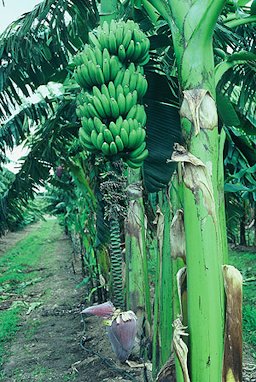 Fig. 58 Also named 'Sweetheart'. 'FHIA-03' was released by FHIA in 1987 and is a dwarf cooking banana, bred from parents in the Bluggoe sub-group. 'FHIA-03' can be distinguished by the pseudostem colour which is bright light green with no, or very few, blotches. 'FHIA-03' is the only FHIA hybrid with this characteristic. 6 'FHIA-17' (AAAA) 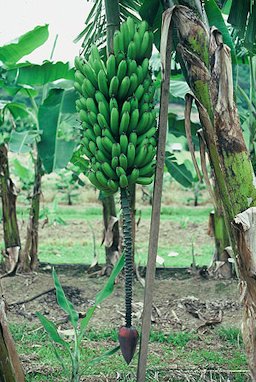 Fig. 59 'FHIA-17' is a Gros Michel type dessert banana developed by FHIA. It has excellent agronomic performance and is considered to be resistant to Mycosphaerella fungi, tolerant to Fusarium oxysporum f. sp. cubense and banana weevil and susceptible to Banana bunchy top virus, Xanthomonas campestris pv. musacearum and the burrowing nematode Radopholus similis. 'FHIA-17' was developed by the breeding programme of FHIA and released in 1989. It has been evaluated against pests and diseases in more than 50 countries. 'FHIA-17' plants grow 3 m to 3.5 m tall under ideal conditions and have a robust cylindrical pseudostem that is light green to green with more or less abundant dark brown blotches, and decumbent leaves. The bunch is cylindrical and the fruit bearing parts hangs horizontal to the general axis of the bunch. The fruits are light green, semi-curved and 21 cm to 25 cm long1. The ripe fruit is pale yellow and pulp is a cream colour. The male flowers remain attached to the bunch rachis, which is thick with deep internodes and has a slight pronounced curvature (though plants with a clean rachis have also been observed, Jeff Daniells, pers. comm. 2013). The petiole channel is open, with erect margins and a purple line on the borders. The internal and external sides of the petiole channel are reddish. 'FHIA-17' is a dessert banana that tastes similar to 'Gros Michel', one of its parent cultivars, but has softer flesh. 7 'FHIA-18' (AAAB) 'Bonanza', 'Bananza' (Australia) 'FHIA-18' is used as a dessert banana. The flavour is bittersweet, similar to an apple. 'FHIA-23' (AAAA) FHIA-23 has a green to light-green pseudostem with more or less abundant dark brown blotches. The bunch hangs perpendicular to the pseudostem. The rachis is bare with a slightly arched curvature and the internodes are fine and shallow. The petiole channel is open with winged margins, is thin and light green on both sides. 37 'FHIA-25' (AAB)  Fig. 60 'FHIA-25' is a cooking banana that was selected in 1997. It was bred by FHIA to be resistant to black leaf streak. The plant is short (2.5 to 3 m) and its pseudostem is green to light green with more or less abundant dark brown blotches. 8 AA. AAA. AAB. AB. ABB. BB. BBB. AAAA. AABB. AAAB. ABBB
Parthenocarpy did not evolve in M. balbisiana as it did in M. acuminata. Thus, edible diploid cultivars of the species do not exisht. BB clones that are cultivated, such as 'Tani' (Thailand), are grown for their leaves and for animal feed. 5 AA. AAA. AAB. AB. ABB. BB. BBB. AAAA. AABB. AAAB. ABBB
Philippine ABB clones such as 'Cardaba' and 'Saba' were classified previously as BBB. Whether an uncommon clone in Thailand, 'Kluai Lep Chang Kut', is BBB is unclear. 5 AA. AAA. AAB. AB. ABB. BB. BBB. AAAA. AABB. AAAB. ABBB
There are seven species of Australimusa and a group of parthenocarpic edible types – known as Fe’i bananas – have also evolved within this section. These cultivars are distinguished by their erect bunches and red sap and are found almost exclusively in the Pacific region. Plants in the Australimusa section are generally tall, with seeded fruit, and distinctive green or greenish-yellow buds (if present). Their seed structure is important for classification purposes, either subglobose or compressed, smooth, striate, tuberculate, or irregularly angled. The Diversity in the genus Musa: Focus on Australimusa, International Network for the Improvement of Banana and Plantain pdf 'Fehi' of 'Fe'i' The 'Fehi' or 'Fe'i' group, of Polynesia, is distinguished by the erect bunches and the purplish-red or reddish-yellow sap of the plants which has been used as ink and for dyeing. In addition to their erect bunches, they also can be recognized by their bright magenta to dark purple sap, heavily ridged, squarish red/coppery fruit, and near-iridescent orange or yellow fruit flesh. The fruit of some clones is exceptionally high in beta carotene (see e.g., Englberger and Lorens 2004). Although they can be quite sensitive during the establishment phase and some are susceptible to Panama disease, they are generally vigorous, tolerate most diseases and pests, and require little care once established. The plants may reach 36 ft and the leaves are 20 to 30 in wide. The bunches have about 6 hands of orange or copper-colored, thick skinned fruits which are starchy, sometimes seedy, of good flavor when boiled or roasted. These plants are often grown as ornamentals in Hawaii. 3 W.O. Lessard writes: " The 'Fehi' or 'Fe'i' is one of the few edible Australimusas and it must be cooked before it is eaten. To eat it without cooking is to invite stomach distress. The flower of the 'Fe'i' is unsusual in that the emerging flower is bright green and as the female flowers open the fruit is copper colored. As is the case with all Autralimusas, the fruit does not hang pendant but grows straight up. The flavor of the 'Fe'i' is rather sweet before it is cooked but is even sweeter after it is baked. The root system of the 'Fe'i' is unusal in that the suckers are rarely produced close to the plant if the growing conditions are good. They act more like a rhizome and run away from the parent plant for a foot or so before they turn and grow upward." 2
'Fei' bananas, like this Afara from Tahiti, often have orange-coloured flesh (Fig. 62). The colour indicates the presence of carotenoids, some of which have vitamin A activity. One of the characteristics of 'Fei' bananas is the colour of their sap. This purple sap (Fig. 63) is produced by Utin Iap, as this 'Fei' cultivar is known on the Micronesian island of Pohnpei. The petiole base of 'Fei' bananas is characteristically frilly (Fig. 64). The leaves of Fei bananas usually have strong cross-corrugations (Fig. 65). 9
The orange 'Fei' banana known as Karat in the Micronesian island of Pohnpei contains 100 times more provitamin A carotenoids than the white 'Cavendish' banana that dominates the export trade (Fig. 66). 9 Karat bananas belong to a group of bananas called Fe’i (or Fehi). Domesticated in the Pacific region and introduced early in Pohnpei, Fe’i bananas are easily recognized by their erect bunch. Prior to 1998, you couldn't buy Karat bananas in the markets of Kolonia, the capital of the Pohnpei State. Nowadays, the three types grown on the island can be found alongside the other bananas (Fig. 67). 33 Two other Fe’i bananas, Utin Mwas (left) and Utin Iap, have higher levels of vitamin A precursors than Karat bananas, but are rarely seen in markets Fig. 68). 33 Further Reading Pohnpei bananas, a Photo Collection: carotenoid-rich varieties, Secretariat of the Pacific Community, Suva, Fiji pdf Back to Banana Page Bibliography
1 Crane, Jonathan H., and Carlos F. Balerdi. "Bananas Growing in the Home Landscape." Dept. of Horticultural Sciences, UF/IFAS, HS10, Original pub. Oct. 1971 as FC-10, Revised Jan. 1998, Dec. 2005, Oct. 2008, and Nov. 2016, Reviewed Dec. 2019, AskIFAS, edis.ifas.ufl.edu/mg040. Accessed 24 Mar. 2017, 3 Aug. 2020. 2 The complete Book of Bananas. W. O. Lessard, 1992. 3 Fruits of Warm Climates. Julia F. Morton, Miami, 1987. 4 "Lacatan banana." Wikipedia, wikipedia.org. Accessed 24 Aug. 2014. 5 Ploetz, Randy C., et al. "Banana and plantain, an overview with emphasis on Pacific island cultivars." Species Profiles for Pacific Island Agroforestry, Feb. 2007, traditionaltree.org. Accessed 24 Aug. 2014. 6 Musapedia contributors. "FHIA-01." Musapedia, the banana knowledge compedium, Version 61, Last modified on 21 Mar. 2014, (CC BY-NC-SA 3.0), www.promusa.org. Accessed 25 Aug. 2014. 7 Musapedia contributors. "FHIA-17." Musapedia, the banana knowledge compedium, Version 43, Last modified on 21 Mar. 2014, (CC BY-NC-SA 3.0), www.promusa.orgA. ccessed 25 Aug. 2014. 8 Musapedia contributors. "FHIA-17." Musapedia, the banana knowledge compedium, Version 18, Last modified on 21 Mar. 2014, (CC BY-NC-SA 3.0), www.promusa.org. Accessed 26 Aug. 2014. 9 Vezina, Anne. "Fei Bananas." Musapedia, the banana knowledge compedium, Version 53, Last modified on 1 July 2014, (CC BY-NC-SA 3.0), www.promusa.org. Accessed 26 Aug. 2014. 10 Musapedia contributors. "Bluggoe." Musapedia, the banana knowledge compedium, Version 15,. Last modified on 21 May 2014, (CC BY-NC-SA 3.0), www.promusa.org. Accessed 26 Aug. 2014. 11 Musapedia contributors. "Gros Michel". Musapedia, the banana knowledge compedium, Version 44, Last modified on 28 Mar. 2014, (CC BY-NC-SA 3.0), www.promusa.org. Accessed 26 Aug. 2014. 12 Vezina, Anne. "Cavendish subgroup." Musapedia, the banana knowledge compedium, Version 59, Last modified 28 July 2020, (CC BY-NC-SA 3.0), www.promusa.org/Cavendish+subgroup. Accessed 26 Aug. 2014, 9 Mar. 2023. 13 Vezina, Anne, et al. "Williams." Musapedia, the banana knowledge compedium, Version 43, Last modified 23 July 2020, (CC BY-NC-SA 3.0), www.promusa.org/Williams. Accessed 26 Aug. 2014, 9 Mar. 2023. 14 Vézina, Anne, and Inge Van den Bergh. "Iholena subgroup." Musapedia, the banana knowledge compedium, Last modified 22 July 2020, (CC BY-NC-SA 3.0), www.promusa.org/Iholena+subgroup. Accessed 26 Aug. 2014, 9 Mar. 2023. 15 Van den Bergh, Inge, et al. "Gerei Langi." Musapedia, the banana knowledge compedium, Last modified 18 July 2017, (CC BY-NC-SA 3.0), www.promusa.org/Gerei+Langi?page_ref_id=94. Accessed 26 May 2014, 9 Mar. 2023. 16 Van den Bergh, Inge, et al. "Iholena Lele." Musapedia, the banana knowledge compedium, Last modified 25 July 2017, (CC BY-NC-SA 3.0), www.promusa.org/Iholena+lele?page_ref_id=93. Accessed 29 May 2014, 9 Mar. 2023. 17 Daniells, J. "Illustrated guide to the Identification of banana varieties in the South Pacific." ACIAR Monograph No. 33, 43p,.1 Mar. 1995, aciar.gov.au. Accessed 30 Aug. 2014. 18 Vezina, Anne, et al. "AA genome group." Musapedia, the banana knowledge compedium, Last modified 27 Sept. 2017, (CC BY-NC-SA 3.0), www.promusa.org/AA+genome+group. Accessed 30 May 2014, 9 Mar. 2023. 19 Vezina, Anne, et al. "Maoli-Popoulu subgroup." Musapedia, the banana knowledge compedium, Last modified 25 July 2019, (CC BY-NC-SA 3.0), www.promusa.org/Maoli-Popoulu+subgroup. Accessed 30 May 2014, 9 Mar. 2023. 20 Vezina, Anne, et al. "Plantain Subgroup." Musapedia, the banana knowledge compedium, Last modified 17 July 2020, (CC BY-NC-SA 3.0), www.promusa.org/Plantain+subgroup. Accessed 30 Aug. 2014, 9 Mar. 2023. 21 "Rhino Horn Banana." Wikipedia, wikipedia.org. Accessed 30 Aug. 2014. 22 Vezina, Anne, et al. "Pome Subgroup." Musapedia, the banana knowledge compedium, Last modified 13 Sept. 2016, (CC BY-NC-SA 3.0), www.promusa.org/Pome+subgroup. Accessed 30 May 2014, 9 Mar. 2023. 23 Vezina, Anne. "Silk Subgroup." Musapedia, the banana knowledge compedium, Last modified 25 Apr. 2019, (CC BY-NC-SA 3.0), www.promusa.org/Silk+subgroup. Accessed 31 May 2014, 9 Mar. 2023. 24 Vezina, Anne, et al. "Latundan." Musapedia, the banana knowledge compedium, Last modified 7 Aug. 2018, (CC BY-NC-SA 3.0), www.promusa.org/Latundan?page_ref_id=96. Accessed 31 May 2014, 9 Mar. 2023. 25 Van den Bergh, Inge, et al. "Pisang Awak." Musapedia, the banana knowledge compedium, Last modified 17 Julky 2020, (CC BY-NC-SA 3.0), www.promusa.org/Pisang+Awak. Accessed 31 May 2014, 9 Mar. 2023. 26 Musapedia contributors. "Saba." Musapedia, the banana knowledge compedium, Last modified 11 Aug. 2020, (CC BY-NC-SA 3.0), www.promusa.org/Saba. Accessed 31 May 2014, 9 Mar. 2023. 27 "'Senorita' banana." Wikipedia, wikipedia.org. Accessed 2 Sept. 2014. 28 "'Blue Java' banana." Wikipedia, wikipedia.org. Accessed 2 Sept. 2014. 29 "'Saba' banana." Wikipedia, wikipedia.org. Accessed 2 Sept. 2014. 30 "Thousand Fingers." Just Fruits and Exotics, justfruitsandexotics.com. Accessed 2 Sept. 2014. 31 "Musa 'Dwarf "Cavendish', 'Pisang Raja'." Top Tropicals, toptropicals.com. Accessed 2 Sept. 2014. 32 "'Goldfinger' banana." Wikipedia, wikipedia.org. Accessed 2 Sept. 2014. 33 Vezina, Anne. "The bananas of Pohnpei." Musapedia, the banana knowledge compedium, 7 Aug. 2015, (CC BY-NC-SA 3.0). www.promusa.org/blogpost404-The-bananas-of-Pohnpei. Accessed 24 Apr. 2018. 34 Ploetz, R.C., et al. "Banana and plantain: an overview with emphasis on Pacific island cultivars Musaceae (banana family)." Species profiles for Pacific Island agroforestry, Permanent Agriculture Resources, Holualoa (USA), 2007, (CC BY-NC-SA 3.0), www.musalit.org/seeMore.php?id=12234. Accessed 25 Apr. 2018. 35 Valmayor, R.V., et al. "The Wild and Cultivated Bananas of the Philippines." PARRFI, Los Banos, Laguna, Philippines, 2002, (CC BY-NC-SA 3.0), www.musalit.org/seeMore.php?id=15028. Accessed 25 Apr. 2018. 36 Anne Vézina, et al. "'Gros Michel.' Musapedia, the banana knowledge compedium, Last modified 27 September 2017, (CC BY-NC-SA 3.0), www.promusa.org/Gros+Michel. Accessed 25 Apr. 2018. 37 Alvarez, J. M., et al. "Identification and characterization guide for FHIA banana and plantain hybrids." Bioversity International, Montpellier. 15p. 2008, (CC BY-NC-SA 3.0), www.musalit.org/seeMore.php?id=11677. Accessed 25 Apr. 2018. Photographs Fig. 1 Starr, Forest, and Kim. "Musa acuminata (banana) 'Sucrier', Waihee, Maui." Starr Environmental, 2013, (CC BY 4.0), starrenvironmental.com. Accessed 13 Jan. 2015. Fig. 2,5,37,42,43,44,47,48,54,56 Maguire, Ian. "'Goldfinger' FHIA-01', 'FHIA 02', 'Thousand Fingers', 'Bluggoe'." Tropical Fruit Photography Picture Archive, trec.ifas.ufl.edu. Accessed 26 Aug. 2014. Fig. 3 Obsidian Soul. "The skin of overripe Lacatan Bananas typically turn black." Wikipedia, 2011, wikipedia.org. Accessed 24 Aug. 2014. Fig. 4 Barona, L. "Philippine Lakatan." Musapedia, the banana knowledge compedium, (CC BY-NC-SA 4.0), www.promusa.org. Accessed 26 Aug. 2014. Fig. 6 Cirad, Jenny, C. "Gros Michel at a glance." Musapedia, the banana knowledge compedium, (CC BY-NC-SA 4.0), www.promusa.org. Accessed 26 Aug. 2014. Fig. 7 Kay Kepler, Angela. "Gros Michel." Musapedia, the banana knowledge compedium, 2007, (CC BY-NC-SA 4.0), www.promusa.org. Accessed 26 Aug. 2014. Fig. 8 Jackson, Karen. "Banana Series." 2013, www.growables.org. Fig. 9 N734LQ. ."Banana on Countertop." Wikipedia, 2007, wikipedia.org. Accessed 31 Aug. 2014. Fig. 10 Rsika. "Banana farm. Chinawal village, Maharashtra, India." Wikipedia, 2012, (CC BY-SA 3.0), wikipedia.org. Accessed 31 Aug. 2014. Fig. 11 Starr, Forest, and Kim. "Musa acuminata (banana) Gran Nain, Hawea Pl Olinda, Maui." Starr Environmental, 2012, (CC BY 4.0), starrenvironmental.com. Accessed 13 Jan. 2015. Fig. 12 Starr, Forest, and Kim. "Musa acuminata (banana) Valery, Maui County Fair, Kahului, Maui." Starr Environmental, 2009, (CC BY 4.0), starrenvironmental.com. Accessed 13 Jan. 2015. Fig. 13 Kay Kepler, Angela. "'Williams'." Pacific Wide Consulting, Musapedia, the banana knowledge compedium, 2003.(CC BY-NC-SA 4.0), www.promusa.org. Accessed 26 Aug. 2014. Fig. 14 Kay Kepler, Angela. "Fruit tip of a 'Williams' cultivar." Pacific Wide Consulting, Musapedia, the banana knowledge compedium, 2006, (CC BY-NC-SA 4.0), www.promusa.org. Accessed 26 Aug. 2014. Fig. 16 Dilmen, Nevit. "Red banana in Tanzania." Wikimedia Commons, 2010, (CC BY-SA 3.0), commons.wikimedia.org. Accessed 2 Sept. 2014. Fig. 16a NukeNinja. "Red banana From Tamil Nadu." Wikimedia Commons, 2015, (CC BY-SA 4.0), commons.wikimedia.org. Accessed 21 Mar. 2017. Fig. 16b Genet. "Musa acuminata (AAA Group) 'Red Dacca' - red banana." Wikimedia Commons, 2012, (CC BY-SA 3.0), commons.wikimedia.org. Accessed 21 Mar. 2017. Fig. 17,18,19,20,21,22,23 Sachter-Smith, Gabriel. "Gerei Langi." Musapedia, the banana knowledge compedium, 2011, (CC BY-NC-SA 4.0), www.promusa.org. Accessed 26 Aug. 2014. Fig. 24,25 Kepler, Angela. "Iholena Lele." Musapedia, the banana knowledge compedium, (CC BY-NC-SA 4.0), www.promusa.org. Accessed 29 Aug. 2014. Fig. 26,28 Vezina, Anne. "'Maoli', ' Popoulu' and 'Hua Moa' bananas." Bioversity International, Musapedia, the banana knowledge compedium, 2009, (CC BY-NC-SA 4.0), www.promusa.org. Accessed 30 Aug. 2014. Fig. 27 Bronson, Eric. "AE AE banana." I likE plants!, 2011, (CC BY-NC-SA 3.0), ilikerareplants.blogspot.com. Accessed 1 Sept. 2014. Fig. 29 Khaytarova, Marina. "'Hua Moa' banana." Top Tropicals, toptropicals.com. Accessed 2 Sept. 2014. Fig. 30 Vezina, Anne. "Huamoa." Bioversity International, Musapedia, the banana knowledge compedium, 2008, (CC BY-NC-SA 4.0), www.promusa.org. Accessed 30 Aug. 2014. Fig. 31,33,34 Adheka, Joseph. "French Plantain, False Horn Plantain and Horn Plantain." Musapedia, the banana knowledge compedium, (CC BY-NC-SA 4.0), www.promusa.org. Accessed 30 Aug. 2014. Fig. 32 Markham, Richard. "French Horn Plantain". Bioversity International, Musapedia, the banana knowledge compedium, (CC BY-NC-SA 4.0), www.promusa.org. Accessed 30 Aug. 2014. Fig. 38,39,40 Starr, Forest, and Kim. "Musa x paradisiaca (banana, maia) Raja Puari, Pali o Waipiio Huelo, Maui, Hawai'i." Starr Environmental, 2013, (CC BY 4.0), starrenvironmental.com. Accessed 2 Sept. 2014. Fig. 45 Starr, Fores,t and Kim. "Ripe Blue Java fruit, Maui County Fair, Kahului, Maui, Hawai'i." Starr Environmental, 2009, (CC BY 4.0), starrenvironmental.com. Accessed 2 Sept. 2014. Fig. 49 "Praying Hands." Top Tropicals, toptropicals.com. Accessed 31 Aug. 2014. Fig. 50 Molina, Augustin. "'Saba.'" Bioversity International, Musapedia, the banana knowledge compedium, 2005, (CC BY-NC-SA 4.0), www.promusa.org. Accessed 31 Aug. 2014. Fig. 51 Obsidian Soul. "The angular squarish fruits of the Saba banana." Wikipedia, 2011, wikipedia.org.. Accessed 2 Sept. 2014. Fig. 52 Obsidian Soul. "Sliced 'Saba' bananas." Wikipedia, 2008, wikipedia.org. Accessed 2 Sept. 2014. Fig. 53,57,58,59,60 Daniells, Jeff. "'FHIA-01' 'FHIA-02', 'FHIA 03', 'FHIA 17', 'FHIA 25' at a glance." Musapedia, the banana knowledge compedium, (CC BY-NC-SA 4.0), www.promusa.org. Accessed 26 Aug. 2014. Fig. 55 Daniells, Jeff. "'FHIA-01' bunch being weighed in Australia." Musapedia, the banana knowledge compedium, (CC BY-NC-SA 4.0), www.promusa.org. Accessed 26 Aug. 2014. Fig. 61 "'Fei' bananas at a glance." Musapedia, the banana knowledge compedium, (CC BY-NC-SA 4.0), www.promusa.org. Accessed 26 Aug. 2014. Fig. 62 Vezina, Anne. "Fei' bananas, like this Afara from Tahiti, often have orange-coloured flesh." Bioversity International, Musapedia, the banana knowledge compedium, 2009, (CC BY-NC-SA 4.0), www.promusa.org. Accessed 26 Aug. 2014. Fig. 63,66 Lois, Englberger. "Sap of 'Fei' Banana and Carotenoid-rich Fei Banana." Island Food Community of Pohnpei, Musapedia, the banana knowledge compedium, 2005, (CC BY-NC-SA 4.0), www.promusa.org. Accessed 26 Aug. 2014. Fig. 64 Vezina, Anne. "The petiole base of 'Fei' bananas is characteristically frilly." Bioversity International, Musapedia, the banana knowledge compedium, 2009, (CC BY-NC-SA 4.0), www.promusa.org. Accessed 26 Aug. 2014. Fig.65 Vezina, Anne. "Leaf of the 'Fei' Banana." Bioversity International, Musapedia, the banana knowledge compedium, 2009, (CC BY-NC-SA 4.0), www.promusa.org. Accessed 26 Aug. 2014. Fig. 66 Englberger, L. "The orange Fei banana known as Karat in the Micronesian island of Pohnpei contains 100 times more provitamin A carotenoids than a white-fleshed banana." Island Food Community of Pohnpei, Musapedia, the banana knowledge compedium, July 2005, (CC BY-NC-SA 4.0), www.musarama.org/en/image/carotenoid-rich-fei-banana-47.html. Accessed 25 Apr. 2018. Fig. 67 Vezina, Anne. "Fei bananas, like this Afara from Tahiti, often have orange-coloured flesh." Bioversity International, Musapedia, the banana knowledge compedium, July 2009, (CC BY-NC-SA 4.0), www.musarama.org/en/image/orange-fleshed-fei-banana-50.html. Accessed 25 Apr. 2018. Fig. 68 Englberger, L. "The bananas of Pohnpei." Musapedia, the banana knowledge compedium, 7 Aug.2015, (CC BY-NC-SA 4.0), www.promusa.org/blogpost404-The-bananas-of-Pohnpei. Accessed 25 Apr. 2018. Note: Images with no accreditation are from donors who wish to remain anonymous Published 21 March 2013 LR. Last update 9 Mar. 2023 LR |
